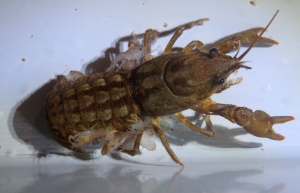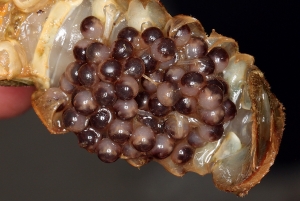ARTICLE / "The White-clawed Crayfish, aim of LIFE Potamo Fauna"
White-clawed Crayfish (Austropotamobius pallipes) are freshwater crustaceans that live in clear and oxygenated rivers. A few years ago they were widely distributed in the watersheds of the rivers of Catalonia and southern Europe. The introduction of American origin crayfishes (Procambarus clarkii and Pacifastacus leniusculus) brought with them the crayfish plague, a disease caused by Aphanomyces astaci, a photosynthetic organism related to brown algae and diatoms. It is a disease that Americans species are resistant to but, instead, is strikingly lethal for White-clawed Crayfish. Since then, the decline has become an endangered species and prone to continuous reduction of their populations (IUCN 2013). In fact, it has been confined to a few sections of the river that have not been reached by the alien species.
In the 90’s a monitoring project began, especially in the basins of the Fluvià, Ter and Muga. In 2004 the crayfish operation center in Molí de les Fonts in Olot, was created, with the dual aim of having a genetic reservoir and provide young crabs to make reinforcements population. It also carried the coordination, monitoring and development of surviving populations.
The LIFE project Potamo Fauna joined this dynamic and raises the recovery of the main population of Austropotamobius pallipes in Natura 2000 Network areas in the basins of the rivers Ter and Muga, reinforced by units from the population with breeding center in Olot. In this sense, the processes to increase juvenile production have been optimized and improved. The juveniles born in May 2015 will be released during the month of September, some 15 new populations that LIFE project contemplated to strengthen the metapopulational structures in each basin.
Moreover, protective measures against crayfish plague are carried out by controlling local populations of crabs trying to eradicate exotic species such as Orconectes limosus, recently established in the area. The aim is to reduce the current rate of disappearance of White-clawed Crayfish.
Another line of action in the framework of the LIFE project is the monitoring of populations, which by now, are beginning to provide a very accurate snapshot of the distribution, essential to carry out proper assessment of their populations. Nor forget the task of spreading awareness about the problem of conservation of the species and, finally, in the context of advancing knowledge, research and information sharing among the 21 and 25 September, when an International Symposium on the Conservation of European Native Freshwater Crayfish will be held in.


















